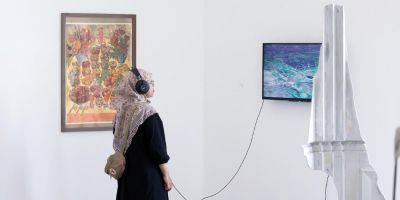Interpretations – going online for 2020

Dr Helen Graham introduces the exhibitions curated by this year’s MA students as part of their Interpretations module.
Interpretations is a core module for MA Art Gallery and Museum Studies, MA Arts Management and Heritage Studies and MA Curating Science. Using an action learning approach, students are supported to learn about object research, interpretive practice, text writing, visual communication and marketing.
In usual times our MA students would be opening up their ‘in-real-life’ exhibitions across campus right now, in collaboration with our diverse and rich campus galleries and archives.
Yet 2020 has meant we needed to think digitally and move online. We decided to make the most of this shift and enable students to work with exciting international collections – from the Rijksmuseum to Smithsonian – using a professional digital platform, Omeka.
The result is a fascinating set of online exhibitions connecting collections to current issues and challenges – with University of Leeds students as the key audience.
Online exhibitions
Explore the nine online exhibitions created by our MA students.
-
We have the exploration of how public opinion in terms of the safety of vaccines in Convincing The Nation: Building public trust from the origins of vaccination to the age of COVID-19, drawing on the Science Museum Group collections.
-
The Wellcome Collection has been used to explore how beauty has been sold as health through looking at advertising since 1880 in Still doing what it says on the tin. The curation group are calling for audiences to share examples of contemporary advertising that falls into the same pattern.
-
York Museums Trust archaeological collections have been interpreted to explore the global connections between Yorkshire and the world – really showing this is not a new phenomenon – in Strings Attached: The Ties That Bind Yorkshire to its Global History.
-
Existence is resistance: The Metropolitan Museum as a Contact Zone explores how The Metropolitan Museum of Art might decolonise its approach to indigenous cultural heritage, juxtaposing objects that trace often violent encounters between colonisers and settler and indigenous people with voices of present day Native American activism.

-
Drawing on a collection of photographs from the Rijksmuseum depicting women from Indonesia, Whose Image? probes the question of how women have been represented by others and how they have come to represent themselves.
-
The Smithsonian Institution’s approach to repatriation of objects to Native American is the focus of Authenticity: Repatriation, Replicating, Revisualising where replicas have become a major strategy, challenging quite fundamentally the focus on the ‘real thing’ traditionally associated with museums. Authenticity has come to focus less on objects themselves and towards trying to build more authentic relationships with communities.
-
The Fragile Deep is an exploration – using The Biodiversity Library – of how humans are connected to and have influenced the seas over the years and in particular on how humans have caused damage to the eco-systems of the sea through climate change.
-
The Yale Center for British Art is used for a comparative view of facing coverings in Masking Faces: The Many Meanings of Face Coverings, where the contexts of theatre, masquerade and balls and religion show their different uses. The exhibition asks: how these histories might inform our take up of masks in the time of COVID-19?
-
Sanctuary: A Digital Green Space uses the Art Institute of Chicago collection to look at the importance of green spaces during this year’s lockdown. This exhibition shares a variety of artworks that prompt us to consider how nature enters our lives, they also call for students to share pictures of the green spaces near them.
In the final week of term students, will share their exhibitions and open up a dialogue with external curators and interpreters from the Smithsonian, National Science and Media Museum, York Museums Trust and Ikon.
Images
Edward Jenner vaccinating patients in the Smallpox and Inoculation Hospital at St. Pancras: the patients develop features of cows. Edited coloured etching by J. Gillray, 1802. Credit: Wellcome Collection. Attribution-NonCommercial 4.0 International (CC BY-NC 4.0). Masks added by MA student Jordan Findlay.
Dress, Native American Traditional Dress from Teton Sioux tribe. Photograph from the Metropolitan Museum of Art online collection. Image edited by MA student Farah Dailami.




